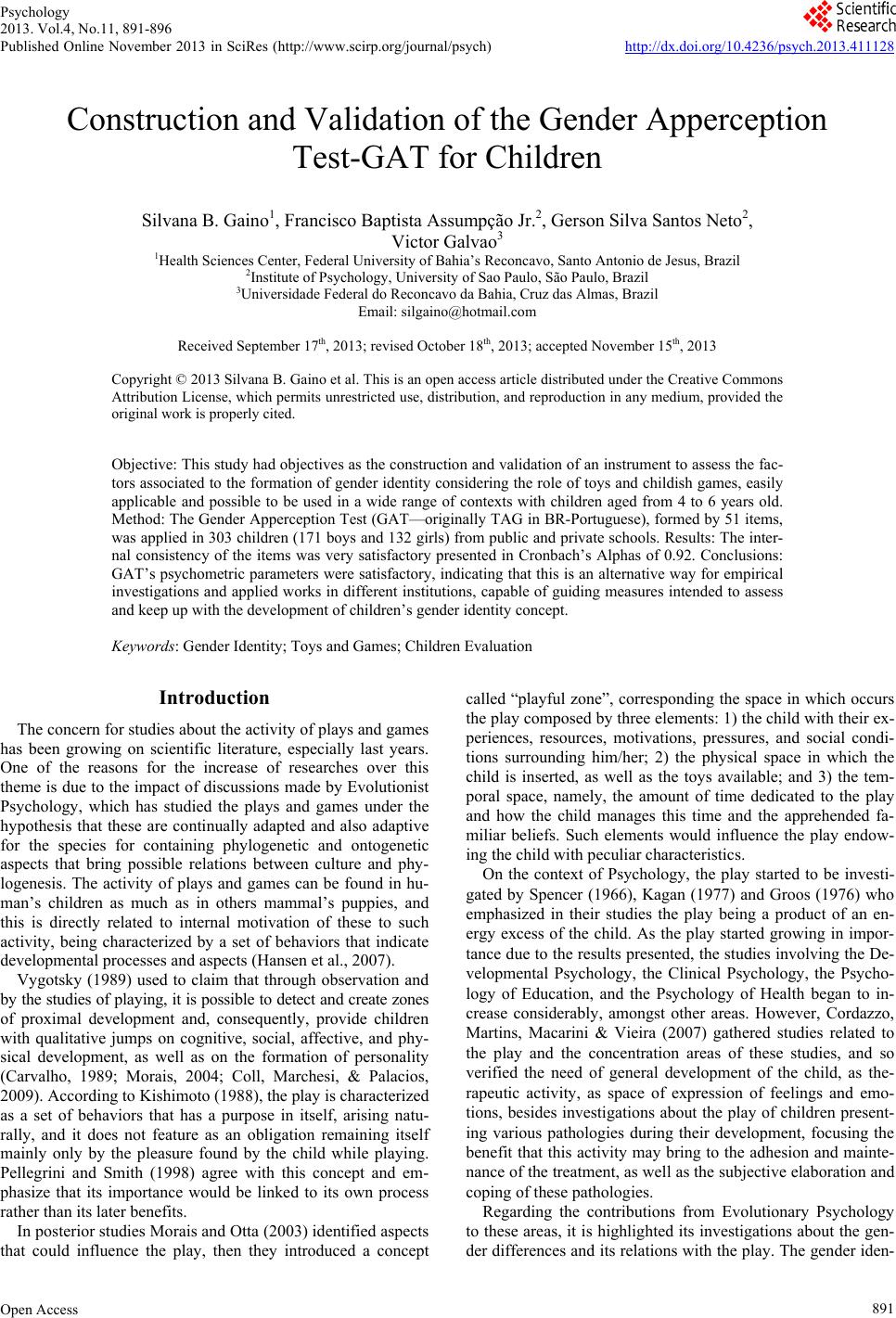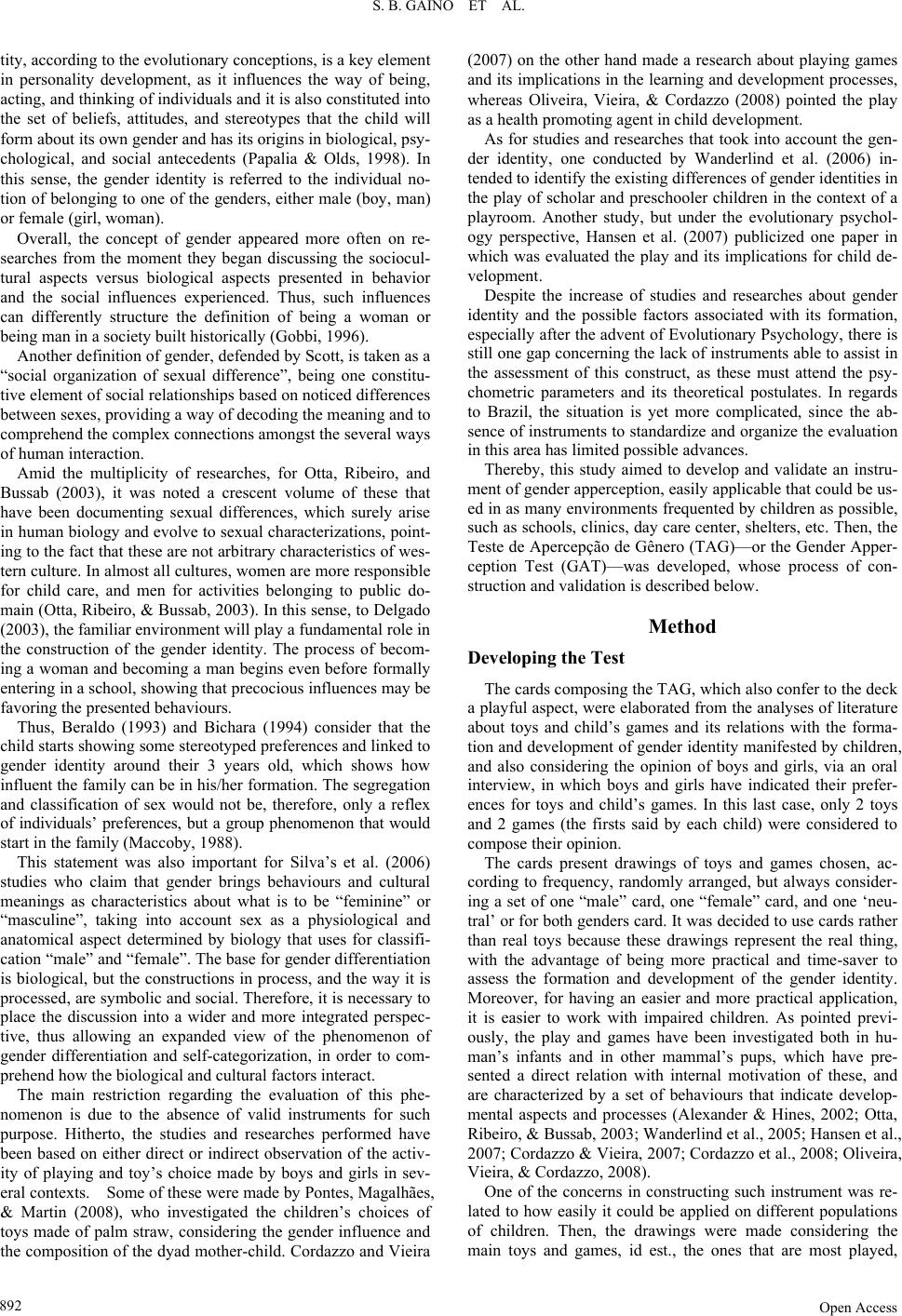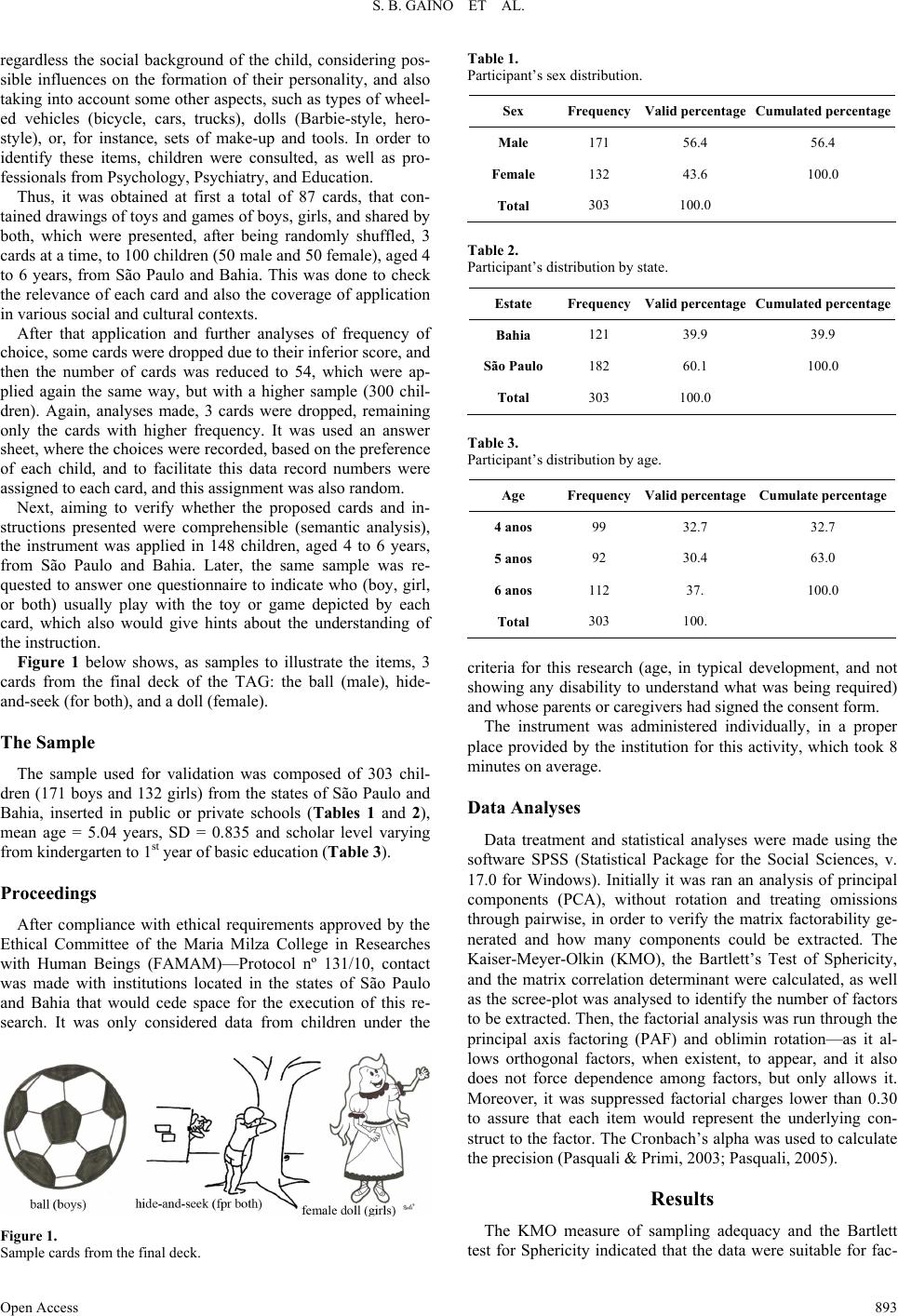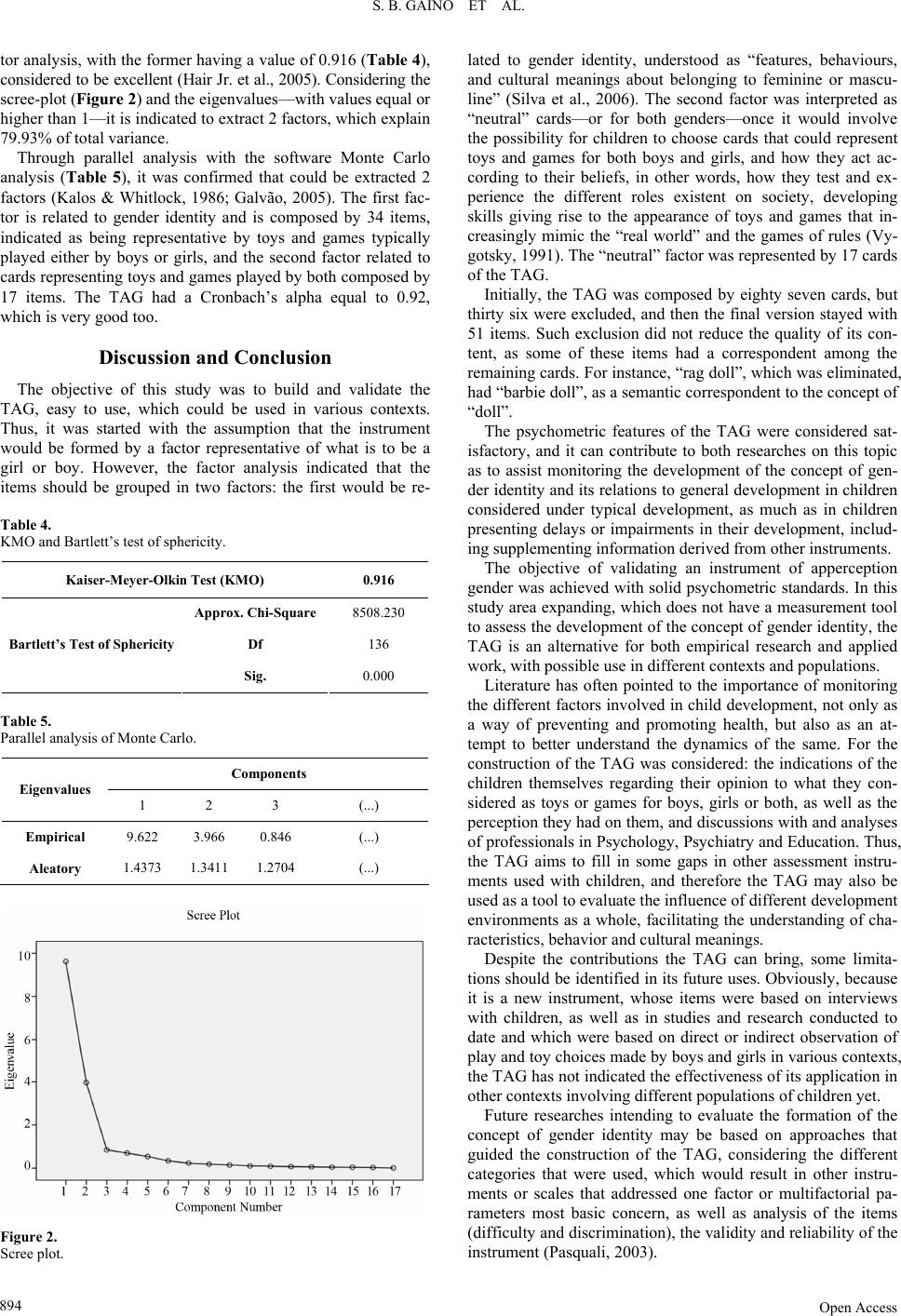 Psychology 2013. Vol.4, No.11, 891-896 Published Online November 2013 in SciRes (http://www.scirp.org/journal/psych) http://dx.doi.org/10.4236/psych.2013.411128 Open Access 891 Construction and Validation of the Gender Apperception Test-GAT for Children Silvana B. Gaino1, Francisco Baptista Assumpção Jr.2, Gerson Silva Santos Neto2, Victor Galvao3 1Health Sciences Center, Federal Univers i t y of Bahia’s Reconcavo, Sa n t o A n t o nio de Jesus, Brazil 2Institute of Psychology, University of Sao Paulo, São Paulo, Brazil 3Universidade Federal do R e c on c a v o d a Bahia, Cruz das Almas, Brazil Email: silgaino@hotmail.com Received September 17th, 2013; revised October 18th, 2013; a c c ep t e d N o v e mber 15th, 2013 Copyright © 2013 Silvana B. Gaino et al. This is an open access article distributed under the Creative Commons Attribution License, which permits unrestricted use, distribution, and reproduction in any medium, provided the original work is properly cited. Objective: This study had objectives as the construction and validation of an instrument to assess the fac- tors associated to the formation of gender identity considering the role of toys and childish games, easily applicable and possible to be used in a wide range of contexts with children aged from 4 to 6 years old. Method: The Gender Apperception Test (GAT—originally TAG in BR-Portuguese), formed by 51 items, was applied in 303 children (171 boys and 132 girls) from public and private schools. Results: The inter- nal consistency of the items was very satisfactory presented in Cronbach’s Alphas of 0.92. Conclusions: GAT’s psychometric parameters were satisfactory, indicating that this is an alternative way for empirical investigations and applied works in different institutions, capable of guiding measures intended to assess and keep up with the development of children’s gender identity concept. Keywords: Gender Identity; Toys and Games; Children Evaluation Introduction The concern for studies about the activity of plays and games has been growing on scientific literature, especially last years. One of the reasons for the increase of researches over this theme is due to the impact of discussions made by Evolutionist Psychology, which has studied the plays and games under the hypothesis that these are continually adapted and also adaptive for the species for containing phylogenetic and ontogenetic aspects that bring possible relations between culture and phy- logenesis. The activity of plays and games can be found in hu- man’s children as much as in others mammal’s puppies, and this is directly related to internal motivation of these to such activity, being characterized by a set of behaviors that indicate developmental processes and aspects (Hansen et al., 2007). Vygotsky (1989) used to claim that through observation and by the studies of play ing, it is possible to detect and create zones of proximal development and, consequently, provide children with qualitative jumps on cognitive, social, affective, and phy- sical development, as well as on the formation of personality (Carvalho, 1989; Morais, 2004; Coll, Marchesi, & Palacios, 2009). According to Kishimoto (1988), the play is characterized as a set of behaviors that has a purpose in itself, arising natu- rally, and it does not feature as an obligation remaining itself mainly only by the pleasure found by the child while playing. Pellegrini and Smith (1998) agree with this concept and em- phasize that its importance would be linked to its own process rather than it s la ter benefits. In posterior studies Morais and Otta (2003) identified aspects that could influence the play, then they introduced a concept called “playful zone”, corresponding the space in which occurs the play composed by three elements: 1) the child with their ex- periences, resources, motivations, pressures, and social condi- tions surrounding him/her; 2) the physical space in which the child is inserted, as well as the toys available; and 3) the tem- poral space, namely, the amount of time dedicated to the play and how the child manages this time and the apprehended fa- miliar beliefs. Such elements would influence the play endow- ing the child with peculiar characteristics. On the context of Psychology, the play started to be investi- gated by Spencer (1966), Kagan (1977) and Groos (1976) who emphasized in their studies the play being a product of an en- ergy excess of the child. As the play started growing in impor- tance due to the results presented, the studies involving the De- velopmental Psychology, the Clinical Psychology, the Psycho- logy of Education, and the Psychology of Health began to in- crease considerably, amongst other areas. However, Cordazzo, Martins, Macarini & Vieira (2007) gathered studies related to the play and the concentration areas of these studies, and so verified the need of general development of the child, as the- rapeutic activity, as space of expression of feelings and emo- tions, besides investigations about the play of children present- ing various pathologies during their development, focusing the benefit that this activity may bring to the adhesion and mainte- nance of the treatment, as well as the subjective elaboration and coping of these pathologies. Regarding the contributions from Evolutionary Psychology to these areas, it is highlighted its investigations about the gen- der differences and its relations with the play. The gender iden-  S. B. GAINO ET AL. tity, according to the evolutionary conceptions, is a key element in personality development, as it influences the way of being, acting, and thinking of individuals and it is also constituted into the set of beliefs, attitudes, and stereotypes that the child will form about its own gender and has its origins in biological, psy- chological, and social antecedents (Papalia & Olds, 1998). In this sense, the gender identity is referred to the individual no- tion of belonging to one of the genders, either male (boy, man) or female (girl, woman). Overall, the concept of gender appeared more often on re- searches from the moment they began discussing the sociocul- tural aspects versus biological aspects presented in behavior and the social influences experienced. Thus, such influences can differently structure the definition of being a woman or being man in a society built historically (Gobbi, 1996). Another definition of gender, defended by Scott, is taken as a “social organization of sexual difference”, being one constitu- tive element of social relationships based on noticed differences between sexes, providing a way of decoding the meaning and to comprehend the complex connections amongst the several ways of human interaction. Amid the multiplicity of researches, for Otta, Ribeiro, and Bussab (2003), it was noted a crescent volume of these that have been documenting sexual differences, which surely arise in human biology and evolve to sexual characterizations, point- ing to the fact that these are not arbitrary characteristics of wes- tern culture. In almost all cultures, women are more responsible for child care, and men for activities belonging to public do- main (Otta, Ribeiro, & Bussab, 2003). In this sense, to Delgado (2003), the familiar environment will play a fundamental role in the construction of the gender identity. The process of becom- ing a woman and becoming a man begins even before formally entering in a school, showing that precocious influences may be favoring the presented behaviours. Thus, Beraldo (1993) and Bichara (1994) consider that the child starts showing some stereotyped preferences and linked to gender identity around their 3 years old, which shows how influent the family can be in his/her formation. The segregation and classification of sex would not be, therefore, only a reflex of individuals’ preferences, but a group phenomenon that would start in the family (Maccoby, 1988). This statement was also important for Silva’s et al. (2006) studies who claim that gender brings behaviours and cultural meanings as characteristics about what is to be “feminine” or “masculine”, taking into account sex as a physiological and anatomical aspect determined by biology that uses for classifi- cation “male” and “female”. The base for gender differentiation is biological, but the constructions in process, and the way it is processed, are symbolic and social. Therefore, it is necessary to place the discussion into a wider and more integrated perspec- tive, thus allowing an expanded view of the phenomenon of gender differentiation and self-categorization, in order to com- prehend how the biological and cultural factors interact. The main restriction regarding the evaluation of this phe- nomenon is due to the absence of valid instruments for such purpose. Hitherto, the studies and researches performed have been based on either direct or indirect observation of the activ- ity of playing and toy’s choice made by boys and girls in sev- eral contexts. Some of these were made by Pontes, Magalhães, & Martin (2008), who investigated the children’s choices of toys made of palm straw, considering the gender influence and the composition of the dyad mother-child. Cordazzo and Vieira (2007) on the other hand made a research about playing games and its implications in the learning and development processes, whereas Oliveira, Vieira, & Cordazzo (2008) pointed the play as a health promoting agent in child development. As for studies and researches that took into account the gen- der identity, one conducted by Wanderlind et al. (2006) in- tended to identify the existing differences of gender identities in the play of scholar and preschooler children in the context of a playroom. Another study, but under the evolutionary psychol- ogy perspective, Hansen et al. (2007) publicized one paper in which was evaluated the play and its implications for child de- velopment. Despite the increase of studies and researches about gender identity and the possible factors associated with its formation, especially after the advent of Evolutionary Psychology, there is still one gap concerning the lack of instruments able to assist in the assessment of this construct, as these must attend the psy- chometric parameters and its theoretical postulates. In regards to Brazil, the situation is yet more complicated, since the ab- sence of instruments to standardize and organize the evaluation in this area has limited possible advances. Thereby, this study aimed to develop and validate an instru- ment of gender apperception, easily applicable that could be us- ed in as many environments frequented by children as possible, such as schools, clinics, day care center, shelters, etc. Then, the Teste de Apercepção de Gênero (TAG)—or the Gender Apper- ception Test (GAT)—was developed, whose process of con- struction and validation is described below. Method Developing the Test The cards composing the TAG, which also confer to the deck a playful aspect, were elaborated from the analyses of literature about toys and child’s games and its relations with the forma- tion and development of gender identity manifested by children, and also considering the opinion of boys and girls, via an oral interview, in which boys and girls have indicated their prefer- ences for toys and child’s games. In this last case, only 2 toys and 2 games (the firsts said by each child) were considered to compose their opinion. The cards present drawings of toys and games chosen, ac- cording to frequency, randomly arranged, but always consider- ing a set of one “male” card, one “female” card, and one ‘neu- tral’ or for both genders card. It was decided to use cards rather than real toys because these drawings represent the real thing, with the advantage of being more practical and time-saver to assess the formation and development of the gender identity. Moreover, for having an easier and more practical application, it is easier to work with impaired children. As pointed previ- ously, the play and games have been investigated both in hu- man’s infants and in other mammal’s pups, which have pre- sented a direct relation with internal motivation of these, and are characterized by a set of behaviours that indicate develop- mental aspects and processes (Alexander & Hines, 2002; Otta, Ribeiro, & Bussab, 2003; Wanderlind et al., 2005; Hansen et al., 2007; Cordazzo & Vieira, 2007; Cordazzo et al., 2008; Oliveira, Vieira, & Cordazzo, 2008). One of the concerns in constructing such instrument was re- lated to how easily it could be applied on different populations of children. Then, the drawings were made considering the main toys and games, id est., the ones that are most played, Open Access 892  S. B. GAINO ET AL. regardless the social background of the child, considering pos- sible influences on the formation of their personality, and also taking into account some other aspects, such as types of wheel- ed vehicles (bicycle, cars, trucks), dolls (Barbie-style, hero- style), or, for instance, sets of make-up and tools. In order to identify these items, children were consulted, as well as pro- fessionals from Psychology, Psychiatry, and Education. Thus, it was obtained at first a total of 87 cards, that con- tained drawings of toys and games of boys, girls, and shared by both, which were presented, after being randomly shuffled, 3 cards at a time, to 100 children (50 male and 50 female), aged 4 to 6 years, from São Paulo and Bahia. This was done to check the relevance of each card and also the coverage of application in various social and cultural contexts. After that application and further analyses of frequency of choice, some cards were dropped due to their inferior score, and then the number of cards was reduced to 54, which were ap- plied again the same way, but with a higher sample (300 chil- dren). Again, analyses made, 3 cards were dropped, remaining only the cards with higher frequency. It was used an answer sheet, where the choices were recorded, based on the preference of each child, and to facilitate this data record numbers were assigned to each card, and this assignment was also random. Next, aiming to verify whether the proposed cards and in- structions presented were comprehensible (semantic analysis), the instrument was applied in 148 children, aged 4 to 6 years, from São Paulo and Bahia. Later, the same sample was re- quested to answer one questionnaire to indicate who (boy, girl, or both) usually play with the toy or game depicted by each card, which also would give hints about the understanding of the instruction. Figure 1 below shows, as samples to illustrate the items, 3 cards from the final deck of the TAG: the ball (male), hide- and-seek (for bot h ) , a n d a doll (female). The Sample The sample used for validation was composed of 303 chil- dren (171 boys and 132 girls) from the states of São Paulo and Bahia, inserted in public or private schools (Tables 1 and 2), mean age = 5.04 years, SD = 0.835 and scholar level varying from kindergarten to 1st year of basic education (Table 3). Proceedings After compliance with ethical requirements approved by the Ethical Committee of the Maria Milza College in Researches with Human Beings (FAMAM)—Protocol nº 131/10, contact was made with institutions located in the states of São Paulo and Bahia that would cede space for the execution of this re- search. It was only considered data from children under the Figure 1. Sample cards from the final deck. Table 1. Participant’s sex distribution. Sex FrequencyValid percentage Cumulated percentage Male 171 56.4 56.4 Female 132 43.6 100.0 Total 303 100.0 Table 2. Participant’s distribution by state. Estate FrequencyValid percentage Cumulated percentage Bahia 121 39.9 39.9 São Paulo 182 60.1 100.0 Total 303 100.0 Table 3. Participant’s distribution by age. Age FrequencyValid percentage Cumulate percentage 4 anos 99 32.7 32.7 5 anos 92 30.4 63.0 6 anos 112 37. 100.0 Total 303 100. criteria for this research (age, in typical development, and not showing any disability to understand what was being required) and whose parents or caregivers had signed the consent form. The instrument was administered individually, in a proper place provided by the institution for this activity, which took 8 minutes on average. Data Analyses Data treatment and statistical analyses were made using the software SPSS (Statistical Package for the Social Sciences, v. 17.0 for Windows). Initially it was ran an analysis of principal components (PCA), without rotation and treating omissions through pairwise, in order to verify the matrix factorability ge- nerated and how many components could be extracted. The Kaiser-Meyer-Olkin (KMO), the Bartlett’s Test of Sphericity, and the matrix correlation determinant were calculated, as well as the scree-plot was analysed to identify the number of factors to be extracted. Then, the factorial analysis was run through the principal axis factoring (PAF) and oblimin rotation—as it al- lows orthogonal factors, when existent, to appear, and it also does not force dependence among factors, but only allows it. Moreover, it was suppressed factorial charges lower than 0.30 to assure that each item would represent the underlying con- struct to the factor. The Cronbach’s alpha was used to calculate the precision (Pasquali & Primi, 2003; Pasquali, 2005). Results The KMO measure of sampling adequacy and the Bartlett test for Sphericity indicated that the data were suitable for fac- Open Access 893  S. B. GAINO ET AL. tor analysis, with the former having a value of 0.916 (Table 4), considered to be excellent (Hair Jr. et al., 2005). Considering the scree-plot (Figure 2) and th e eigenvalues—with values equal or higher than 1—it is indicated to extract 2 factors, which explain 79.93% of total variance. Through parallel analysis with the software Monte Carlo analysis (Table 5), it was confirmed that could be extracted 2 factors (Kalos & Whitlock, 1986; Galvão, 2005). The first fac- tor is related to gender identity and is composed by 34 items, indicated as being representative by toys and games typically played either by boys or girls, and the second factor related to cards representing toys and games played by both composed by 17 items. The TAG had a Cronbach’s alpha equal to 0.92, which is very good too. Discussion and Conclusion The objective of this study was to build and validate the TAG, easy to use, which could be used in various contexts. Thus, it was started with the assumption that the instrument would be formed by a factor representative of what is to be a girl or boy. However, the factor analysis indicated that the items should be grouped in two factors: the first would be re- Table 4. KMO and Bartlett’s test of sphericity. Kaiser-Meyer-Olkin Test (KMO) 0.916 Approx. Chi-Square 8508.230 Df 136 Bartlett’s Test of Sphericity Sig. 0.000 Table 5. Parallel analysis of M on te C a rlo. Components Eigenvalues 1 2 3 (...) Empirical 9.622 3.966 0.846 (...) Aleatory 1.4373 1.3411 1.2704 (...) Figure 2. Scree plot. lated to gender identity, understood as “features, behaviours, and cultural meanings about belonging to feminine or mascu- line” (Silva et al., 2006). The second factor was interpreted as “neutral” cards—or for both genders—once it would involve the possibility for children to choose cards that could represent toys and games for both boys and girls, and how they act ac- cording to their beliefs, in other words, how they test and ex- perience the different roles existent on society, developing skills giving rise to the appearance of toys and games that in- creasingly mimic the “real world” and the games of rules (Vy- gotsky, 1991). The “neutral” factor was represented by 17 cards of the TAG. Initially, the TAG was composed by eighty seven cards, but thirty six were excluded, and then the final version stayed with 51 items. Such exclusion did not reduce the quality of its con- tent, as some of these items had a correspondent among the remaining cards. For instance, “rag doll”, which was eliminated, had “barbie doll”, as a semantic correspondent to the concept of “doll”. The psychometric features of the TAG were considered sat- isfactory, and it can contribute to both researches on this topic as to assist monitoring the development of the concept of gen- der identity and its relations to general development in children considered under typical development, as much as in children presenting delays or impairments in their development, includ- ing supplementing information derived from other instruments. The objective of validating an instrument of apperception gender was achieved with solid psychometric standards. In this study area expanding, which does not have a measurement tool to assess the development of the concept of gender identity, the TAG is an alternative for both empirical research and applied work, with possible use in different contexts and populations. Literature has often pointed to the importance of monitoring the different factors involved in child development, not only as a way of preventing and promoting health, but also as an at- tempt to better understand the dynamics of the same. For the construction of the TAG was considered: the indications of the children themselves regarding their opinion to what they con- sidered as toys or games for boys, girls or both, as well as the perception they had on them, and discussions with and analyses of professionals in Psychology, Psychiatry and Education. Thus, the TAG aims to fill in some gaps in other assessment instru- ments used with children, and therefore the TAG may also be used as a tool to evaluate the influence of different development environments as a whole, facilitating the understanding of cha- racteristics, behavior and cultural meanings. Despite the contributions the TAG can bring, some limita- tions should be identified in its future uses. Obviously, because it is a new instrument, whose items were based on interviews with children, as well as in studies and research conducted to date and which were based on direct or indirect observation of play and toy choices made by boys and girls in various contexts, the TAG has not indicated the effectiveness of its application in other contexts involving different populations of children yet. Future researches intending to evaluate the formation of the concept of gender identity may be based on approaches that guided the construction of the TAG, considering the different categories that were used, which would result in other instru- ments or scales that addressed one factor or multifactorial pa- rameters most basic concern, as well as analysis of the items (difficulty and discrimination), the validity and reliability of the instrument (Pasquali, 2003). Open Access 894  S. B. GAINO ET AL. Factors directly or indirectly associated to the concept of gender identity could also be better explored by investigating in greater detail the different environments of inclusion of chil- dren, such as family environment, which according to Delgado (2003) will play a role in the construction of gender identities. The survey conducted by Cordazzo, Martins, Macarini & Vi- eira (2007) regarding studies related to play and areas of con- centration of these studies, confirms the need for further re- search involving the evaluation of the importance of play for the overall development of the child, besides investigations on the play of children with different pathologies during its devel- opment. Thus, the TAG is presented as a new potential tool to re- search and comprehend the notion of the concept of gender identity. Nonetheless, further research should be conducted to expand knowledge in this area and improvements in the in- strument itself. Acknowledgements The cartoons composing the card deck were drawn by Eli- zângela Matias (Belê) inspired by characters of social media. REFERENCES Alexander, G. M., & Hines, M. (2002). Sex differences in response to children’s toys in nonhuman primates (Cercopithecus aethiops sa- baeus). Evolution and Human Behavior, 23, 467-479. http://biososial.org/wp-content/uploads/2010/03/Alexander-Hines-20 02.pdf http://dx.doi.org/10.1016/S1090-5138(02)00107-1 Beraldo, K. E. A. (1993). Gênero de brincadeiras na percepção de cri- anças de 5 a 10 anos [Gender of plays in 5 - 10 years old children’s perception.] São Paulo, SP: IPUSP. Bichara, I. D. (1994). Um estudo etológico da brincadeira de faz-de- conta em crianças de 3 - 7 anos [An ethological study of play of pre- tending in 3 - 7 years old children.] Unpublished Doctoral’s disserta- tion, Sao Paulo: University of Sao Pau lo. Carvalho, A. M. A. (1989). Brincar juntos: Natureza e função da inte- ração entre crianças [Playing together: Nature and function of inter- action among children.] In C. Aides (Ed.), Etiologia de animais e de homens/Human and animal Ethology (pp. 199-210). São Paulo: Edi- con/EDUSP. Coll, C., Marchesi, A., & Palácios, J. (2009). Desenvolvimento psicoló- gico e educação: Psicologia Evolutiva [Psychological development and education: Evolutionary Psychology.] Porto Alegre: Artmed. Cordazzo, S. T. D., Martins, G. D. F., Macarini, S. M. and Vieira, M. L. (2007). Perspectivas no estudo do brincar: Um levantamento biblio- gráfico [Perspectives in the study of play: A bibliographical survey.] Aletheia, 26, 122-136. http://pepsic.bvsalud.org/pdf/aletheia/n26/n26a11.pdf Cordazzo, S. T. D., & Vieira, M. L. (2007). A brincadeira e suas im- plicações nos processos de aprendizagem e de desenvolvimento [The play and its consequences in development and learning processes.] Estudos e pesquisas em Psicologia, 1, 89-101. http://www.revispsi.uerj.br/v7n1/artigos/pdf/v7n1a09.pdf Cordazzo, S. T. D., Westphal, J. P., Tagliari, F. B., Vieira, M. L., & Oliveira, A. M. F. (2008). Metodologia observacional para o estudo do brincar na escola [Observational metodology to study the play in the school.] Avaliação Psicológica, 7, 427-438. http://pepsic.bvsalud.org/pdf/avp/v7n3/v7n3a14.pdf Delgado, A. C. C. (2003). Culturas infantis e dimensões da socialização no cotidiano de uma creche domiciliar [Children cultures and dimen- sions of socialization in the routine of a home day care.] Caderno de Educação, 21, 101- 118. http://periodicos.ufpel.edu.br/ojs2/index.php/caduc/index Galvão, M. (2005). Análise quantitativa de riscos com simulação de Monte Carlo [Quantitative analysis of risks with Monte Carlo’s si- mulation.] www.mundopm.com.br/download/montecarlo.pdf Gobbi, M. A. (1996). Lápis vermelho é de mulherzinha: Desenho infan- til, relações de gênero e educação infantil. [Red pencil is for girls: Infantile drawing, gender relations and infantile education.] Mas- ter’s Thesis, Campinas (SP): Unicamp. Groos, K. (1976). The play of animals: Play and instinct. In J. S. Bruner, A. Jolly, & K. Sylva (Eds.), Play. Its role in development and evolu- tion (pp. 65-67). Middlesex: Penguin Books. Hair Júnior, J. F., Anderson, R. E., Tatham, R. L., & Black, W. C. (2005). Análise multivariada de dados [Multivariate analysis of data.] Porto Alegre: Bookman. Hansen, Macarini, Martins et al. (2007). O brincar e suas implicações para o desenvolvimento infantil a partir da Psicologia Evolucionista [The play behaviour and its implications for child development ac- cording to evolutionary psychology.] Revista Brasileira de Cresci- mento e Desenvolvimento humano, 17, 133-143. http://pepsic.bvsalud.org/pdf/rbcdh/v17n2/14.pdf Kagan, G. et al. (1977). Introdução: Algumas perspectivas históricas [Introduction: Some historical perspectives.] In: Desenvolvimento e personalidade da criança (pp. 1-10). São Paulo: Harper e Row do Brasil. Kalos, M. H., & Whitlock, P. A. (1986). Monte carlo methods: Basics. New York: Wiley-Interscience Publication. http://dx.doi.org/10.1002/9783527617395 Kishimoto, T. M. (1988). O brincar e suas teorias [The play and its theories.] São Paulo: P i o n e ira. Maccoby, E. (1988). Gender as a social category. Developmental Psy- chology, 24, 755-765. http://dx.doi.org/10.1037/0012-1649.24.6.755 Morais, M. L. S., & Otta, E. (2003). Entre a serra e o mar [Between the sierra and the sea]. In A. M. A. Carvalho, C. M. C. Magalhães, F. A. R. Pontes, & I. D. Bichara (Eds.), Brincadeira e cultura: Viajando pelo Brasil que brinca (pp. 127-157). São Paulo: Casa do Psicólogo. Morais, M. L. S. (2004). Conflitos e(m) brincadeiras infantis: Diferen- ças culturais e de gênero [Conflicts in children’s play: Cultural and gender differences.] Doctoral Dissertation, Sao Paulo (SP): Univer- sity of Sao Paulo. Oliveira, L. D. B., Vieira, M. L., & Cordazzo, S. T. D. (2008). “Brin- car” como agente promotor de saúde no desenvolvimento infantil [“The play” as promotional agent of health in the child development.] Revista de Ciências Humanas, 42, 193-215. https://periodicos.ufsc.br/index.php/revistacfh/article/view/2178-458 2.2008v42n1-2p193/13335 http://dx.doi.org/10.5007/2178-4582.2008v42n1-2p193 Otta, E., Ribeiro, F. L., & Bussab, V. S. R. (2003). Inato versus adqui- rido: A persistência da dicotomia [Innate vs. Acquired: The persis- tence of the dichotom y.] Revista de Ciências Humanas, 34, 283-311. https://periodicos.ufsc.br/index.php/revistacfh/article/view/25381/22 302 Pasquali, L. (2005). Análise fatorial para pesquisadores [Factorial ana- lysis for researchers]. Brasília: LabPam. Pasquali, L. (2003). Psicometria: Teoria dos testes na psicologia e na Educação [Psychometry: Test’s theory in Psychology and Education.] Petrópolis, RJ: Vozes. Pasquali, L., & Primi, R. (2003). Fundamentos da teoria de resposta ao item—TRI [Basic theory of Item Response Theory—IRT]. Avali- ação Psicológica, 2, 99-110. http://pepsic.bvsalud.org/pdf/avp/v2n2/v2n2a02.pdf Papalia, D. E., & Olds, S. W. (1998). O mundo da criança [The child’s world.] São Paulo: Markon Brooks. Pellegrini, A. D., & Smith, P. K. (1998). The development of play du- ring childhood: Forms and possible functions. Child Psychology & Psychiatry Review, 3, 51-57. http://onlinelibrary.wiley.com/doi/10.1111/1475-3588.00212/pdf http://dx.doi.org/10.1017/S1360641798001476 Pontes, F. A. R., Magalhães, C. M. C., & Martin, W. L. B. (2008). Pre- ferência de crianças no brinquedo de miriti: A influência do gênero e composição da díade [Children’s preferences for Miriti toys: The in- fluence of gender and dyad composition.] Revista Brasileira de Cre- Open Access 895  S. B. GAINO ET AL. Open Access 896 scimento e Desenvolvimento Humano, 18, 170-178. http://pepsic.bvsalud.org/pdf/rbcdh/v18n2/08.pdf Silva, L. I. C., Pontes, F. A. R. , Silva, S. D. B., Magalhã es, C. M. C., & Bichara, I. D. (2006) Diferenças de gêneros nos grupos de brinca- deira na rua: A hipótese de aproximação unilateral [Gender differen- ces in the groups of street play: The hypothesis of unilateral ap- proach.] Psicologi a Reflexão Crítica, 19, 114-121. http://www.scielo.br/pdf/prc/v19n1/31300.pdf http://dx.doi.org/10.1590/S0102-79722006000100016 Scott, J. W. (1995). Gênero: Uma categoria útil de análise histórica [Gender: A useful category of historical analysis.] Educação e Re- alidade, 20, 71-99. https://archive.org/details/scott_gender Spencer, H. (1966). Principles of biology. The works Herbert Spencer. Osnabrüg: Otto Zeller. Vygotsky, L. (1991). A formação social da mente: O Desenvolvimento dos processos psicológicos superiores [The social formation of the mind: The development of superior psychological processes.] São Paulo, SP: Martins Fontes. Vygotsky, L. (1989). O papel do brinquedo no desenvolvimento [The role of toy in human development.] In: M. Cole, V. John-Steiner, S. Scribner, & E. Souberman (Eds.), A formação social da mente (pp. 105-118). São Paulo: Martins Fon tes. Wanderlind, F., Martin s, G. D. F., Ha n s en , J., Macarini , S., & Vieir a, M. L. (2006). Diferenças de gênero no brincar de crianças pré-escolares e escolares na brinquedoteca [Gender differences in play of pre- scholar and scholar’s childre n at to y- lib rary.] Paideia, 16, 263-273. http://www.scielo.br/pdf/paideia/v16n34/v16n34a14.pdf
|